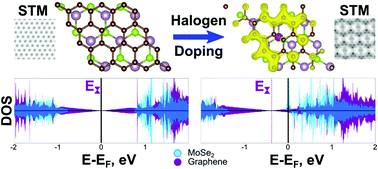Induced spin polarization in graphene via interactions with halogen doped MoS2 and MoSe2 monolayers by DFT calculations†
Abstract
Magnetic halogen doped MoX2 (X = S and Se) monolayers influenced the electronic structure of graphene through a proximity effect. This process was observed using state-of-the-art calculations. It was found that the substitution of a single chalcogen atom with a halogen atom (F, Cl, Br, and I) results in n-type doping of MoX2. An additional electron from the dopant is localized on binding orbitals with the nearest Mo atoms and leads to the formation of magnetism in the dichalcogenide layer. Detailed analysis of halogen doped MoX2/graphene heterostructures demonstrated the induction of spin polarization in graphene near the Fermi energy. Significant spin polarization near the Fermi energy and n-type doping were observed in the graphene layer of MoSe2/graphene heterostructures with MoSe2 doped with iodine. At the same time, fluorine-doped MoSe2 does not cause n-doping in graphene, while spin polarization still takes place. The possibility for the detection of the arrangement of the halogen impurities at the MoX2 basal plane even with the graphene layer deposited on top was demonstrated through STM measurements which will be undoubtedly useful for the fabrication of electronic schemes and elements based on the proposed heterostructures for their further application in nanoelectronics and spintronics.



 Please wait while we load your content...
Please wait while we load your content...